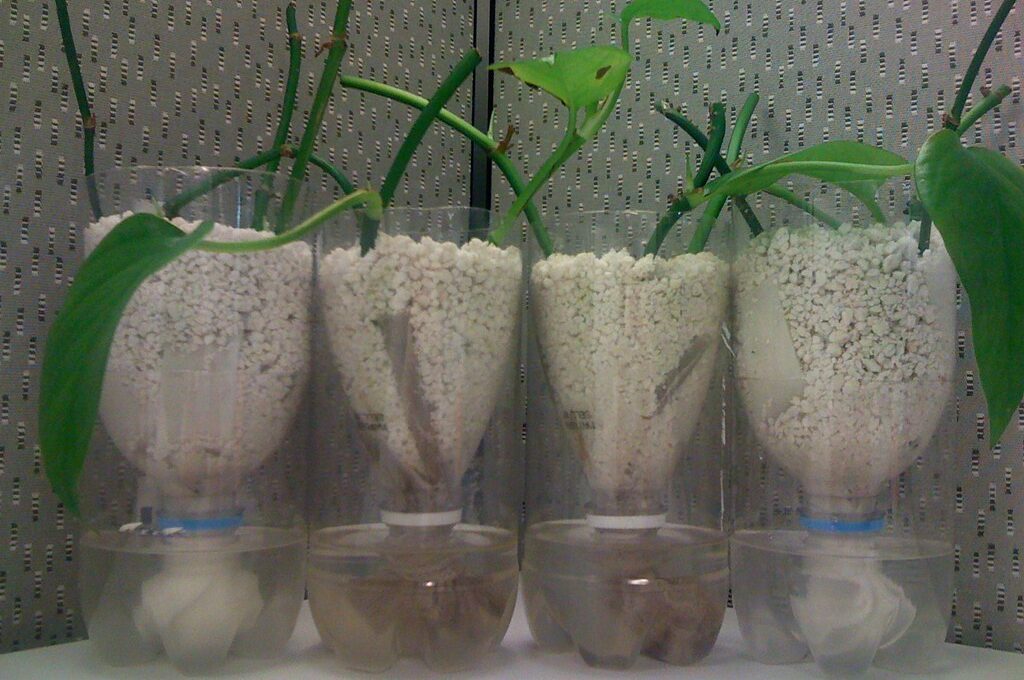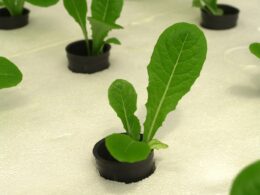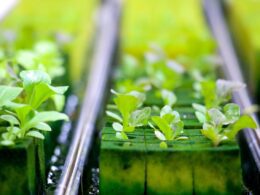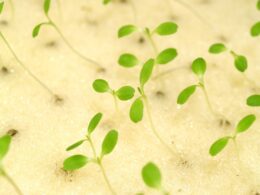Are you interested in hydroponic gardening but concerned about the well-being of your plants? You may be wondering how plants can survive in a water-based system without drowning. The answer lies in the careful balance of water, nutrients, and oxygen in hydroponic systems.
Hydroponic gardening is a method of growing plants without soil, using water and nutrient solutions instead. This system allows plants to grow faster and produce higher yields than traditional soil-based gardening. However, without soil to anchor them, plants in hydroponic systems rely on a healthy balance of water and oxygen to survive.
In this article, we will explore how hydroponic gardeners maintain this balance and ensure the safety of their plants.
Understanding the Basics of Hydroponic Gardening
You’ll quickly grasp the fundamentals of hydroponic gardening and be amazed at how easy it is to grow a thriving garden without soil. Hydroponics is a method of growing plants using water and nutrient solutions instead of soil. The plants are grown in containers filled with a growing medium such as perlite, coconut coir, or rockwool.
To set up a hydroponic garden, you’ll need some basic hydroponic equipment such as a water pump, air pump, and a nutrient solution. You can buy pre-made hydroponic systems, or you can opt for a DIY hydroponic system. The DIY hydroponic system is a cost-effective option that allows you to build your own system using readily available materials.
The beauty of hydroponic gardening is that it allows plants to absorb nutrients and oxygen directly from the water, which ensures that they receive the perfect amount of nutrients they need to grow. This is why plants don’t drown in hydroponics. The nutrient solution in the hydroponic system is aerated, which means that air is pumped into the water to provide the necessary oxygen for the plants.
With hydroponics, you’ll be able to grow plants faster, bigger, and healthier than traditional gardening methods.
The Importance of Oxygen in Hydroponic Systems
To keep your hydroponic plants thriving, it’s crucial to ensure that there’s ample oxygen available in your system. Without oxygen, your plants can’t perform respiration or photosynthesis, which are essential processes for their growth. Fortunately, there are several benefits of aeration that can help you oxygenate your hydroponic system effectively.
One of the primary benefits of aeration is that it increases the amount of dissolved oxygen in your nutrient solution. By using an air pump and air stone, you can infuse oxygen into your water, which your plants can then absorb through their roots. This extra oxygen helps to keep your plants healthy and vigorous, which can translate to higher yields and better quality crops.
There are several oxygenation techniques for hydroponics, including deep water culture, drip irrigation, and nutrient film technique. Each of these methods has its advantages and disadvantages, so it’s important to choose the one that’s right for your particular setup and plants.
By taking the time to oxygenate your hydroponic system properly, you can ensure that your plants have the best chance of thriving and producing healthy, flavorful crops.
Balancing Water and Nutrients
When it comes to hydroponics, balancing water and nutrients is crucial for the health and growth of your plants. The role of nutrient solutions is to provide your plants with the necessary elements for growth. However, choosing the right growing medium is also important for optimal plant health.
In this subtopic, you’ll learn about the importance of balancing water and nutrients, the role of nutrient solutions, and how to choose the right growing medium for your hydroponic system.
The Role of Nutrient Solutions
The nutrient solutions used in hydroponics play a crucial role in providing plants with the necessary nutrients and oxygen to thrive in water-based environments. The plants in hydroponics do not drown because the nutrient solutions are carefully balanced to ensure that the roots have access to the right amount of oxygen.
The nutrient solutions also provide the necessary nutrients for plant growth and development. In hydroponics, plants absorb nutrients directly from the solution, which allows for faster and more efficient nutrient absorption. This method of nutrient delivery also eliminates the need for soil, which can often be a breeding ground for pests and diseases.
Overall, nutrient solutions are an essential component of hydroponics, and their proper use and maintenance can lead to healthy and thriving plants.
Choosing the Right Growing Medium
Picking the perfect growing medium is a vital step in creating a successful hydroponic system. Hydroponic medium options are vast and choosing the right one can be confusing.
Unlike traditional soil-based gardening, hydroponic systems use different types of materials to provide a structure for the plants to grow on and to anchor their roots. Comparing soil vs hydroponic medium, hydroponic mediums are soil-free and provide better aeration and drainage for the roots.
Some popular hydroponic mediums include rockwool, vermiculite, perlite, coconut coir, peat moss, and expanded clay pebbles. These mediums are lightweight, sterile, and can be reused multiple times, making them cost-effective in the long run.
The right hydroponic medium will also allow for optimal water retention and nutrient absorption, ensuring that your plants grow strong and healthy without the risk of drowning.
Maintaining the Optimal Balance
To maintain optimal balance in your hydroponic system, you need to keep a close eye on water levels, adjust nutrient solutions as necessary, and use aeration systems.
Monitoring water levels will help you avoid over or under watering your plants, which can impact growth and yield.
Adjusting nutrient solutions based on plant needs will ensure they have the necessary nutrients for healthy growth.
Finally, aeration systems will help oxygenate the water and prevent root rot.
Monitoring Water Levels
Monitoring water levels is crucial in ensuring the success of your hydroponic setup, so you can rest easy knowing your plants are thriving. Without close observation of water levels, the roots of your plants can become waterlogged, leading to a lack of oxygen and ultimately, their demise.
Here are three things to keep in mind when monitoring water levels in your hydroponic system:
-
Use water level sensors: These devices can help you keep track of the water level in your system without having to constantly check it yourself. They can alert you when the water level is too high or too low, allowing you to make adjustments before your plants suffer.
-
Invest in automated watering systems: Automatic systems can help maintain the optimal water level for your hydroponic setup. By programming them to deliver water at specific intervals, you can ensure that your plants are getting the right amount of water without any guesswork.
-
Check water levels frequently: Even with sensors and automated systems in place, it’s important to check water levels regularly. This will allow you to catch any problems early and make adjustments as needed. By monitoring water levels closely, you can ensure that your plants stay healthy and happy in your hydroponic system.
Adjusting Nutrient Solutions
Adjusting nutrient solutions is an essential aspect of maintaining a thriving hydroponic system, requiring careful attention and precision. pH level management is crucial to ensure that the plants receive adequate nutrients and don’t become waterlogged.
The ideal pH ranges from 5.5 to 6.5 for most plants grown hydroponically. You must regularly check the pH levels and adjust them using pH up or down solutions accordingly.
Nutrient solution concentration is another vital factor to consider when adjusting the solution. Too much or too little concentration can lead to stunted growth, nutrient deficiencies, or even plant death. You should follow the manufacturer’s instructions or consult with a hydroponic expert to determine the appropriate nutrient solution concentration for the plants you are growing.
Regularly monitoring and adjusting the nutrient solution will help ensure that your hydroponic plants thrive and don’t drown.
Using Aeration Systems
You’ll be thrilled to learn about the amazing benefits of using aeration systems in your hydroponic setup. They help your plants grow strong and healthy by introducing oxygen into the nutrient solution. This is essential for the roots to absorb nutrients properly. Without oxygen, the roots can suffocate and eventually die, which can lead to plant stunting or even death.
There are different types of aeration systems available, including air stones, air pumps, and waterfalls. Air stones are small, porous stones that release tiny bubbles into the nutrient solution. Air pumps, on the other hand, push air through tubes and into the solution. Waterfalls create a cascade effect that introduces oxygen into the solution. Whichever type of aeration system you choose, make sure to monitor it closely and clean it regularly to prevent the buildup of algae or other unwanted debris.
By using an aeration system, you’ll be giving your plants the best chance at thriving in your hydroponic setup.
Tips for Successful Hydroponic Gardening
When it comes to hydroponic gardening, choosing the right plants is crucial for success.
You’ll also want to take measures to prevent disease and pests from damaging your crops.
And once it’s time to harvest, proper storage techniques will ensure your produce stays fresh and delicious.
By following these tips, you’ll be well on your way to a thriving hydroponic garden.
Choosing the Right Plants
Picking the perfect plant for your hydroponic system is crucial to ensure a thriving and successful harvest. When choosing your plants, it’s important to consider their species suitability and growth rate.
Not all plants can thrive in hydroponic systems, so it’s important to research which plants are best suited for this type of gardening. Environmental factors affecting plant growth should also be taken into account. For instance, some plants require more light or nutrients than others.
You should also consider the size of the plant and the space it will need to grow. By carefully selecting the right plants, you can ensure that your hydroponic garden will be successful and rewarding.
Preventing Disease and Pests
Preventing disease and pests is essential for a thriving and healthy hydroponic garden, so it’s important to take proactive measures to keep your plants safe.
Here are four items to consider when it comes to preventing pests and managing disease in your hydroponic garden:
-
Regularly inspect your plants for signs of pests or disease. Catching a problem early can prevent it from spreading and causing irreparable damage to your crop.
-
Maintain proper nutrient and pH levels to ensure your plants are healthy and less susceptible to pests and disease.
-
Consider using natural pest control methods, such as introducing beneficial insects or using neem oil, instead of harsh chemicals that can harm your plants and the environment.
-
Practice good hygiene by cleaning your equipment and growing medium regularly to prevent the buildup of harmful bacteria and fungi.
By taking these proactive measures, you can help ensure the health and safety of your hydroponic garden, and ultimately, your own safety as well.
Harvesting and Storage Techniques
To get the most out of your hydroponic harvest, it’s important to understand the proper techniques for harvesting and storing your crops. Proper drying and curing are essential to ensure that your plants maintain their potency and flavor. After harvesting, remove any large leaves and hang the plants upside down in a cool, dark room with good ventilation. This will allow the plants to dry slowly and evenly, which is important for preserving the terpenes and cannabinoids that give your plants their unique aroma and effects.
Once your plants are dry, it’s time to start the curing process. This involves placing your buds in airtight containers and storing them in a cool, dark place. Opening the containers periodically will allow for any excess moisture to escape, which helps prevent mold growth. Proper curing can take anywhere from a few weeks to several months, but the end result is worth the wait. Once your buds are fully cured, you can store them for the long term by vacuum sealing them or placing them in airtight containers with desiccant packets to absorb any excess moisture.
Frequently Asked Questions
How do you set up a hydroponic system?
To set up a hydroponic system, you’ll need to decide if you want to go the DIY route or purchase a pre-made system. If you choose the DIY option, you’ll need materials such as a container, an air pump, air stones, net pots, grow lights, and a growing medium.
Once you have the materials, you’ll need to choose the right plants for your hydroponic garden and optimize their growth by monitoring their pH levels, nutrient levels, and water temperatures. With a pre-made system, the materials and setup are already taken care of, making it a simpler option for beginners.
Whatever route you choose, hydroponic gardening offers a safe and controlled environment for your plants to thrive in.
Can any plant be grown hydroponically?
When it comes to hydroponic plant selection, nearly any type of plant can be grown hydroponically as long as the correct nutrient solution variations are used.
It’s important to choose plants that are well-suited for hydroponic growing conditions and to understand their specific nutrient requirements. By providing the right balance of nutrients, oxygen, and water, hydroponic plants can thrive without the risk of drowning.
Plus, since hydroponic systems eliminate the need for soil, there’s less chance of pests or diseases harming your plants.
With careful plant selection and nutrient management, you can enjoy a bountiful harvest of healthy, vibrant plants in your hydroponic garden.
What are the benefits of hydroponic gardening compared to traditional soil gardening?
Are you looking for a more efficient and environmentally friendly way to grow your plants? Hydroponic gardening might be the answer. Compared to traditional soil gardening, hydroponic gardening offers nutritional advantages and space-saving benefits.
With hydroponic gardening, you can control the nutrients and pH levels of the water, resulting in healthier and faster-growing plants. This method also uses less water and requires less space, making it a great option for those with limited outdoor space or who want to grow plants indoors.
Plus, you won’t have to worry about weeds or soil-borne diseases. So, if you’re looking to reduce your environmental impact and maximize efficiency benefits, consider giving hydroponic gardening a try.
How often should you change the nutrient solution in a hydroponic system?
To ensure your hydroponic plants are healthy and thriving, it’s important to regularly change the nutrient solution in your system. The frequency of solution changes will depend on the size of your system, the types of plants you’re growing, and the nutrient solution composition.
As a general rule, most hydroponic gardeners change their solution every two to three weeks. However, if you notice any issues with your plants, such as yellowing leaves or stunted growth, it may be time to change the solution sooner.
Remember, keeping your nutrient solution fresh and properly balanced is key to a successful hydroponic garden.
What types of pests and diseases are common in hydroponic gardening, and how do you prevent or treat them?
To keep your hydroponic garden healthy and thriving, it’s important to stay on top of common pests and diseases. One effective approach is to use integrated pest management, which involves using a combination of preventative measures and targeted treatments to keep pests and diseases at bay.
This can include things like ensuring proper sanitation practices, using beneficial insects to control pests, and regularly monitoring your plants for signs of trouble. Additionally, it’s important to prevent nutrient deficiencies by using high-quality nutrient solutions and regularly checking the pH and nutrient levels in your system.
By taking these steps, you can help ensure that your hydroponic garden stays healthy and productive.
Conclusion
Congratulations! You now know why plants don’t drown in hydroponics. It all comes down to balancing water and nutrients in the system.
You learned that oxygen is crucial in hydroponic gardening, and that plants take up nutrients through their roots. In a hydroponic system, the water is constantly recirculated, and the roots are suspended in a nutrient-rich solution.
To maintain the optimal balance, you need to monitor the pH level and nutrient levels regularly. You also need to make sure that the water is well-oxygenated and that the roots have enough room to grow.
With the right balance of water, nutrients, and oxygen, your hydroponic plants will thrive and produce a bountiful harvest.
Remember, successful hydroponic gardening takes practice and patience. Don’t be afraid to experiment and adjust your system until you find what works best for you.
With dedication and a little bit of know-how, you’ll be able to grow healthy, vibrant plants without ever getting your hands dirty. Happy gardening!









